Published
on 8
Oct 2011
|
All rights reserved.
|
|
|
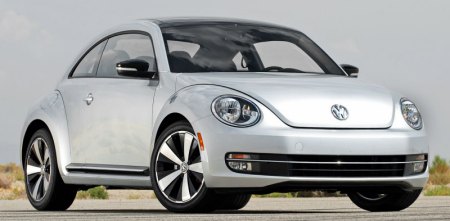
In 1994, designer Freeman
Thomas and J. Mays kickstarted the trend of retro-cars with Volkswagen
Concept 1, which eventually became the New Beetle. They not only
recreated the classic People's Car with modern mechanicals and
packaging, but also redefined the iconic look. The bug-shape profile
evolved to be even more cartoonish, thanks to an arc roof line and
symmetric profile. The light and airy, cab-forward cabin featured a
vase to hold flowers. Naturally, ladies got mad with it. My wife, for
example, is a fan of the New Beetle in apple green. Worth noting is she
has little passion about any Ferrari, Lamborghini or other performance
cars I praised. The New Beetle was that magical. It had a special
attraction to women, including those not interested in cars.
The New Beetle was produced exclusively in Mexico and about half of the
cars were supplied to the US market. In the 13 years it existed, 1.2
million units were produced, pretty good for a niche model with only
one body style and two engines to choose from. Nevertheless, its
reception in Europe had never been warm. European motorists required
more practicality than image, and they found VW Golf a much better bet.
Therefore, in the development of the second generation, the number one
job was to improve its global presence. On the one hand, it has to
narrow the gap from Golf for practicality. On the other hand, it has to
lure not only women but also men.
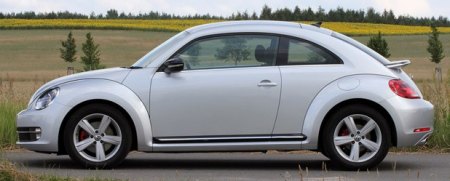
Judging from the new looks, I would say the second approach is probably
overdone. The new Beetle, ridiculously losing the word "New" in its
name, might please more male drivers, but at the same time it loses
attraction to women, as my wife can testify. Its new profile is not
only lower and wider but also far more muscular. The arc roof is
replaced with a flatter and longer one. The windscreen gets more
upright as the base of the windscreen is pushed back. The front bumper
more angular and sophisticated – just like Golf. Interestingly, its
side profile looks closer to the classic Beetle than its direct
predecessor. Depending on your view, you may say it is back to basics,
or you may criticize it for looking older than the old car.
In Turbo trim, the Beetle looks even sportier. 18 or even 19-inch
5-spoke alloy wheels add to the aggression, as is the large tail
spoiler. If Porsche create a people-version 911, it just might look
like this one. On the flip side, the new design has lost the
imagination and romance of the old car. It is more serious than dream.
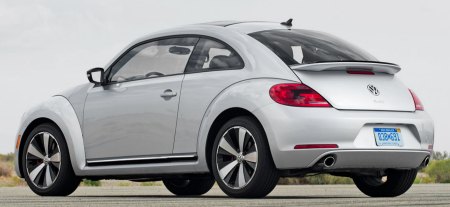
Quite surprising, although it appears to be much lower than the old
car, tape measurement finds its roof stands only 12 mm lower. However,
the car does get much longer (+200 mm) and wider (+80 mm) than the 1997
model, while its wheelbase gets a 30 mm boost to 2537 mm. What does
this mean? More cabin space, of course. The combination of longer
wheelbase and a less sloping rear window translates to a roomier rear
seating space. It can finally hold two average size adults for short
journeys. In contrast, the old car could seat only children at the
back. Behind the cabin, the longer rear overhang significantly enlarged
the boot volume by a full 100 liters to 310 liters. This should please
European customers.
Apart from more space, the cabin is also thoroughly redesigned. The
high-mounted, vertical dashboard is clearly inspired by the original
Beetle, particularly the retro glovebox door. Following the fashion set
by Mini, you can decorate the dashboard and doors with body-color
panels, or even faux carbon-fiber trim on the performance model.
Compare with the old car, its materials and build quality are vastly
improved. However, judging it by the high standard of Golf and most
other Volkswagen products, its build quality could be slightly
disappointed. There are less soft-touched plastics employed, and some
trims could look cheap. Once again, the Mexican manufacturing fails to
deliver the same quality standard as in Europe. Tighter cost control is
also a reason.
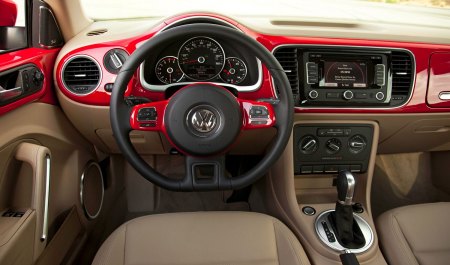
Once you are on the driver seat, you will find the pushed back
A-pillars reward you with a better visibility through corner. The
shorter dash top also results in much less reflection to the
windscreen. Early impression is promising.
Less promising is the mechanical setup. The Beetle shares a lot of
parts with the new Jetta, which is produced in the same Mexican plant.
This means it shares the same cost-saving measures. The regular Beetle
comes with an outdated 2.5-liter five-cylinder engine with 170 hp
output (European version comes with a weak 105hp 1.2 TSI engine
instead), torsion-beam rear suspension and hydraulic power steering.
This compares unfavourably with Golf's fuel-saving 1.4 TSI engine,
multi-link suspension and electromechanical power steering. It does get
the more sophisticated suspension and steering, but only on the
range-topping Turbo model, which shares the 200 hp 2.0 TFSI engine with
Golf GTI. The Turbo also gets DSG twin-clutch gearbox, very aggressive
wheels and tires (235/45VR18), and a cool-looking flat-bottomed
steering wheel.
Thanks to the wider tracks and tires, the new car delivers better
handling than the old, in particular grip and the willingness to turn
into corners. Trouble is, it is not up to the standard of Golf. The
Beetle Turbo is no match with Golf GTI, no matter steering (less
precise and less feel), ride (much stiffer on those aggressive
rubbers), high-speed stability (nervous above 100 mph), body control
(more roll despite of stiffer suspension setting) and quietness (lots
of wind and tire noise). Performance is not as good, too. With a 0.37
coefficient of drag, it tops only 139 mph, 10 mph down on Golf GTI.
0-60 mph claim is 0.2 second slower.
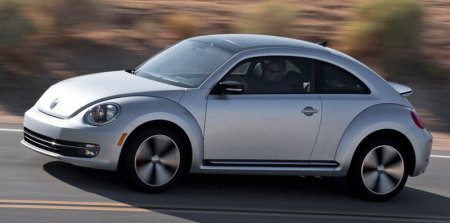
Taking into account the less accommodative rear seats and boot, and the
lack of rear doors, I suppose most motorists will continue to find the
Beetle a choice by heart rather than by brain. From this view, it is
fundamentally the same as the old car. What the new car does bring is a
less painful decision to switch from Golf, as it has fewer compromises
to live with. Well, my wife probably won't agree. In her eyes, the new
look is already a big compromise.
|
Verdict:    |
|